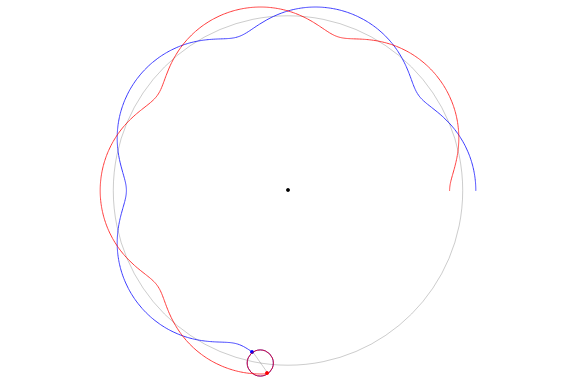Epicycles Revisited; Convexity of Lunar Orbit about the Sun
Epicycles Revisited; Convexity of Lunar Orbit about the Sun
Kepler's laws of planetary motion in the 17th century superseded the Ptolemaic system of epicycles to account for the detailed motions of the planets. Generalizations of epicycloids, called epitroichoids, still do occur, however, in the description of relative planet-moon motions as their barycenters (centers of gravity) follow Keplerian orbits around the Sun.
We consider a simplified idealized case, which is justified in the Details: a moon (red point ) with mass is in a circular orbit about its planet (blue point ) with mass , with the moon-planet distance equal to , where and are the respective distances of the moon and planet from their barycenter. The barycenter of this pair is in a circular orbit of radius about the Sun. With the Sun at the origin, the parametric equations for and can be written
A
m
A
B
m
B
r=a+b
a=+r
m
B
m
A
m
B
b=+r
m
A
m
A
m
B
R
A
B
x
A
y
A
x
B
y
B
where equals the number of lunar cycles per revolution about the Sun. (For the Sun-Earth-Moon system, .) These represent parametric equations for epitroichoids, which reduce to the more familiar epicycloids when and in the first and second set of equations, respectively. In most cases these curves exhibit a looped or cuspoid structure as they traverse the larger circle. All rotations and revolutions shown are counterclockwise.
m
m≈13
m=R/a
m=R/b
This brings us to the remarkable fact that the Moon's orbit around the Sun is a convex curve. This can be explained by the following physical argument. The gravitational force of the Sun on the Moon is always more than twice the gravitational force of the Earth on the Moon: . Thus the net force on the Moon is always directed toward the Sun. But, by Newton's second law, this force is proportional to the second derivative of with respect to time, hence the radial curvature of the orbit is always positive. This implies that the Moon’s orbit is always convex with respect to the Sun. In terms of the epitrochoid parameters, the condition for convexity can be expressed as , which is easily fulfilled for the Sun and Moon. Remarkably, no other known planet-moon couple in the Solar System obeys the convexity condition.
≈2.21
GM
m
a
2
R
G
m
a
m
b
2
r
r
R/a≥
2
m
